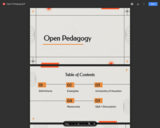
Member presentation to the Houston Area OER (HAOER) Consortium at the April 2024 quarterly meeting
- Subject:
- Open Educational Resources & Practice
- Material Type:
- Teaching/Learning Strategy
- Author:
- Victoria Brame
- Kate Carter
- Date Added:
- 04/25/2024

Member presentation to the Houston Area OER (HAOER) Consortium at the April 2024 quarterly meeting
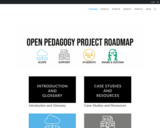
The Open Pedagogy Project Roadmap is a module-based resource that will assist you in planning, finding support for, sharing, and sustaining your open pedagogy project, regardless of its size or scope.

This toolkit is intended as a guide for students who are engaging in open pedagogy. The toolkit defines open pedagogy, the benefits of open pedagogy, and the rights and responsibilities that come with being a student creator. Instructors may wish to use this toolkit as a resource to scaffold conversations about open pedagogy with their students and to appropriately prepare them for working in the open.
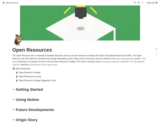
The Open Resource site is intended to facilitate discovery and use of open resources starting with Open Educational Resources (OER). The Open Resource site will continue to develop and change depending on the needs of the community, and are outlined in the future developments section. Essentially it is a place to search for all the places to search for OER.
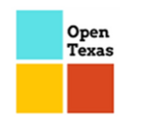
Daniel Williamson, Managing Director of OpenStax at Rice University, presented a webinar about the return of the Open Texas Conference in September 2024. PowerPoint slides from presentation.

Open access is a publishing model that enables the free online accessibility of journal articles and scholarship, permitting any user to read and use these works. Open access fuels innovation through knowledge transfer by reducing barriers to reading discovery, and sharing.

This summary documents the initial collaboration and reported insights of the individual institutions and the NIC as a whole. As the institutions implement their programs, gain new insights, and test improvements, subsequent summary reports will be made available as open education resources on the Perkins Grantee Hub at OERTX.higered.texas.gov.

This resource provides a brief introduction to the Plan-Do-Study-Act cycle, a tool used in design and continuous improvement that involves planning a change, implementing it on a small scale, studying the results, and acting on what was learned to refine or expand the change.
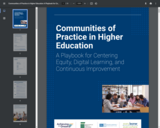
This playbook provides the higher education community with guidance on how to envision, design, facilitate, evaluate, and sustain communities of practice. Communities of practice offer higher education faculty, students, and leaders a range of benefits, such as facilitating resource sharing, individual and collective goal achievement, group problem solving, evaluation of practices, and emergent learning.
The playbook particularly emphasizes three under-explored elements of the communities of practice experience: equity, digital technologies, and continuous improvement. Approaching these elements with intentionality can ensure a reflexive, accessible process that supports all community members. This playbook provides actionable strategies for all who want to learn more about structuring and facilitating communities of practice. It also explicates ways to engage our three-pronged approach through the lifecycle of a community experience.

This resource provides an archival access to a presentation our MCC OER Cohort presented at a faculty and staff professional development day. We wanted to place the document here to allow other MCC cohort members to access.

This resource provides a brief introduction to process mapping, a tool used in design and continuous improvement that involves visually representing the steps, activities, inputs, and outputs of a process or workflow. It includes an editable PowerPoint slide that serves as driver diagram template and example.

The presentation emphasizes the importance of being specific, contextual, and consistent when crafting prompts. It encourages users to treat AI as if explaining to a human, use meta-prompts, and iterate to refine results.Key points covered include:An overview of what AI can and cannot do wellThe importance of human oversight in AI usePrivacy concerns when using AIPractical applications for educators, such as creating learning objectives, quiz questions, discussion prompts, and meeting agendasTips for effective prompt writing

This resource is a template for developing and curating OER ancillary materials for a Public Family Policy course. This template was designed for the OER Advanced Skills series in June 2023.

This policy is a starting point for institutions wishing to develop accessibility policies and practices for their online courses and is designed as a set of dynamic guidelines rather than a legal document. It was created in response to earlier research done by Frey and King (2010) with QM institutions revealing that 87% of respondents did not have an accessibility policy for online programs.

This resource is a template for redesigning a course to include OER. This template was designed for the OER Advanced Skills series in June 2023.The specific resource is being developed for RNSG 2138. Each lesson may be used for another purpose..

This resource is a REMIX of the template for redesigning a course to include OER. This template was designed for the OER Advanced Skills series in June 2023.

This two-part session introduced participants to THECB commissioned statewide OER research that provides the foundation for future resource development and program and service delivery.
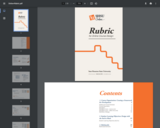
The SHSU Online Course Design Rubric is used to guide and inform the course development process, as well as evaluate the design of any course which contains online components. It can be used whether the course is fully or partially online, flipped or web‐assisted face‐to‐face.
The Rubric was developed by a team of instructional designers and course development practitioners based on nationally recognized, research‐based quality assurance standards related to the essential components of online course design. This includes...
- General course information
- Presentation of course content
- Collaboration & Communication
- Assessment Strategies
- Course Technology
- Learner Support, and
- Accessibility
Not only is the rubric the primary instrument utilized at SHSU for the development and evaluation of online courses, but the tool can also be used as a self‐assessment instrument by instructors as a means to receive constructive feedback on the design of a course, and a means to identify and document effective online course design.
The SHSU Online Course Design Rubric has also been vetted by faculty who are actively involved in online teaching for SHSU. Use of the rubric to inform the development of distance education courses leads to multiple benefits, including...
- Improved student learning
- Ease of navigation of the course environments
- Reduced ambiguity for faculty and students
- More appropriate use of technology

This report shares the results of an OER Gap Analysis completed by the Institute for the Study of Knowledge Management in Education (ISKME) for the Texas Higher Education Coordinating Board (THECB). The analysis identified free, openly licensed full courses and textbooks for 25 highly transferable, high-enrollment courses required for two-year or four-year degree paths in high-wage/high-demand fields. Most courses selected for the scan are also Texas Core Curriculum courses. Texas high-wage/high-demand fields were identified using data from the Texas Workforce Commission and included nursing, business, accounting, computer science, engineering, and health administration. The following courses needed for multiple degree paths in these fields were selected for the scan:Science: Anatomy and Physiology I and II; Biology I; Chemistry I; Physics IMath: College Algebra; Elementary Statistical Methods; Pre-Calculus; Calculus I; Calculus IISocial Sciences: Texas Government; Federal Government; General Psychology; Introduction to Sociology; Principles of Macroeconomics, Principles of MicroeconomicsHumanities: US History I and II; Introduction to Ethics; Introduction to Philosophy; Public Speaking; Composition I; Composition IIBusiness: Business Computer Applications; Principles of Finance
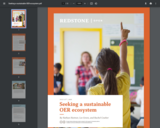
As the collection of available OER – the OER commons – has grown, a collection of institutions and
organizations that contribute to and draw on the commons has developed around it. Sustaining this
“OER ecosystem” of content and stakeholders that transform the content into innovative approaches
in the classroom to improve student experiences is vital to realizing the potential impact of OER. To
inform this report, we conducted over 20 stakeholder interviews, as well as a literature review of OER
and other open-driven industries.